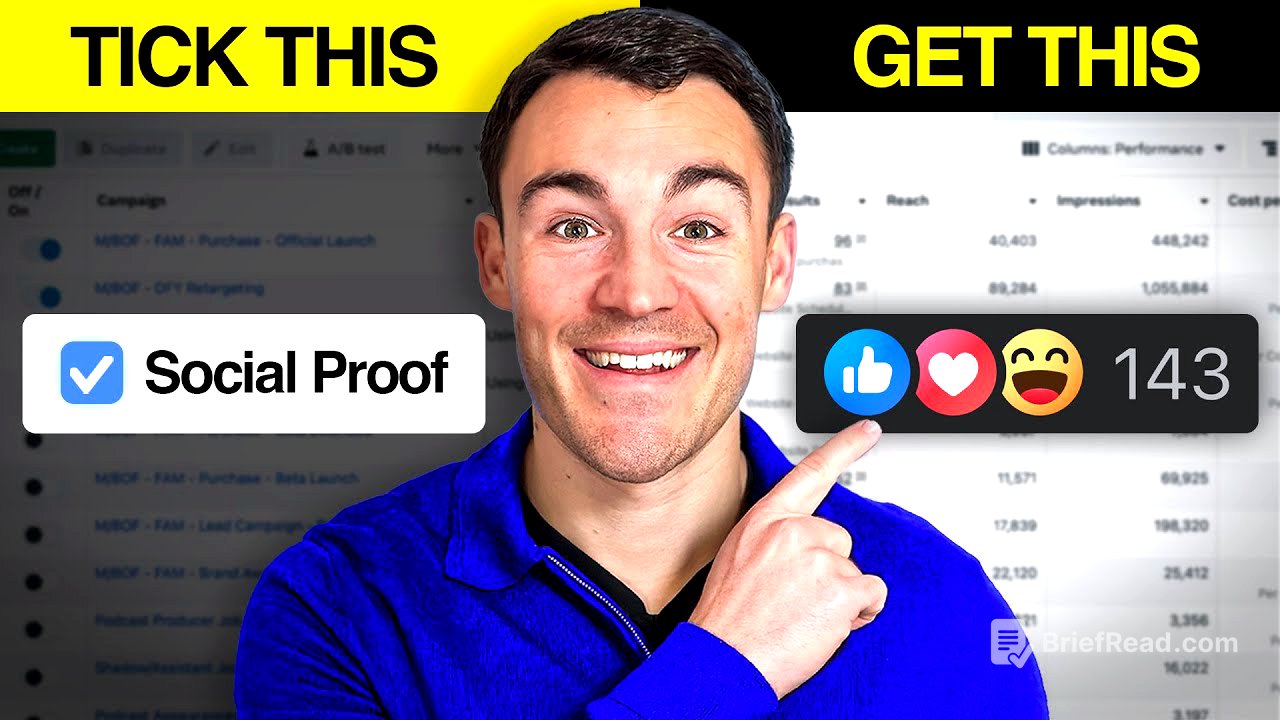TLDR;
This video discusses a new Facebook Ads feature that allows advertisers to combine likes and reactions across similar ads to boost social proof and conversions. It also touches upon strategies advertisers have used to gain social proof, advising against engagement bait and running engagement ads before conversion ads. The video emphasizes the importance of accurate data tracking using Hyros to measure ad performance effectively.
- Meta's new feature combines likes and reactions for similar ads, enhancing social proof.
- Avoid engagement bait tactics that violate Meta's policies.
- Running engagement ads solely to gather social proof before conversion ads is not recommended.
- Accurate data tracking with Hyros is crucial for informed decision-making and optimization.
Introduction to the New Facebook Ads Feature [0:00]
The video introduces a new feature by Meta designed to help Facebook advertisers get more likes and comments on their ads, thereby improving conversion rates. This feature aims to consolidate social proof, making ads more appealing, especially to cold audiences. The presenter navigates to the advertising settings in Ads Manager to demonstrate this new feature.
Locating and Understanding the Social Information Setting [0:14]
To access the feature, one needs to go to advertising settings where a "Social Information" box can be found. This setting allows users to control how Meta displays social information like likes and follows on their ads. The key is a checkbox that combines likes and reactions from similar ads, which the presenter strongly recommends enabling to boost social proof.
The Importance of Social Proof and Potential Benefits [0:50]
The presenter emphasizes that ads with more social proof, such as likes and positive reactions, tend to convert better. This is because significant engagement on an ad gives potential customers confidence in the legitimacy and popularity of the product or company. The consolidation of social proof is particularly beneficial as it prevents the dilution of engagement across multiple ad variations.
Unknowns and Future Testing of the Feature [2:35]
There's uncertainty around how Meta defines "similar" ads for combining social proof. The presenter plans to conduct further testing to understand the criteria and promises to share updates. It's speculated that ads with the same headline or product image leading to the same destination page might qualify for combined social proof.
The Smart Move by Meta and Recommendation to Turn it On [4:19]
The presenter views this feature as a strategic move by Meta to help advertisers achieve better results, encouraging them to stay on the platform and invest more. Enabling this feature is recommended as there are no apparent downsides, and it could significantly improve ad performance by presenting a stronger social proof image.
Mentorship Program Advertisement [4:26]
The presenter briefly promotes a mentorship program designed to help individuals improve their Facebook ad results. The program claims that 82% of its participants see a notable improvement in their ad spend return within 30 days. A link is provided for those interested in learning more.
Strategies to Avoid for Gaining Social Proof [5:04]
The video transitions to discussing strategies advertisers have used to increase social proof, cautioning against tactics that violate Meta's policies. Specifically, it advises against clickbait or engagement bait, where users are required to like, comment, or share to gain something, as this can lead to ad account penalties.
Why Running Engagement Ads First Isn't Ideal [6:04]
The presenter argues against running engagement ads to boost social proof before launching lead or sales-based ads. Engagement ads may not generate as much relevant social proof (likes, reactions, comments) as expected, and the creative might not perform well in subsequent lead or sales campaigns, leading to wasted ad spend.
A Better Approach: Starting with Lead or Sales Campaigns [7:41]
A more effective strategy is to directly launch lead or sales campaigns. Successful ads will naturally accumulate social proof over time as their budget is scaled. This approach allows for testing multiple ads and focusing the budget on those that perform best, avoiding wasted spend on generating engagement for ads that ultimately don't convert.
The Importance of Accurate Data with Hyros [8:32]
The video highlights the importance of accurate data tracking for making informed decisions and optimizing ad performance. Hyros is recommended as a tracking and attribution software that provides more accurate data than Meta's built-in tools, especially given increasing privacy regulations.
Demonstration of Hyros and Its Impact [9:11]
The presenter shares a case study using their Hyros dashboard, illustrating how Hyros identified significantly more revenue generated from a Facebook ad campaign than Meta's reporting. This discrepancy is attributed to Meta's limited attribution window, which fails to capture conversions that occur after 7 days.
Availability and Conclusion [10:42]
The new social proof combination feature is currently available in only some ad accounts but is expected to roll out more widely soon. Advertisers are encouraged to check their advertising settings for the "Social Information" box. The presenter concludes by highlighting Meta's ongoing efforts to release new features and encourages viewers to subscribe for updates and testing results.









